Spinal Flexibility Is an Important Factor for Improvement in Spinal and Knee Alignment after Total Knee Arthroplasty: Evaluation Using a Whole Body EOS System
Abstract
1. Introduction
2. Material and Methods
2.1. Demographics
2.2. Changes in Sagittal Alignment after TKA Considering Lumbosacral Flexibility
2.3. Disparity after TKA Considering Lumbosacral Flexibility
2.4. Statistical Analysis
3. Results
3.1. Changes in Sagittal Alignment after TKA Considering Lumbosacral Flexibility
3.2. Disparity after TKA Considering Lumbosacral Flexibility
4. Discussion
5. Conclusions
Author Contributions
Funding
Conflicts of Interest
References
- Roussouly, P.; Pinheiro-Franco, J.L. Biomechanical analysis of the spino-pelvic organization and adaptation in pathology. Eur. Spine J. 2011, 5, 609. [Google Scholar] [CrossRef] [PubMed]
- Chaleat-Valayer, E.; Mac-Thiong, J.M.; Paquet, J.; Berthonnaud, E.; Siani, F.; Roussouly, P. Sagittal spino-pelvic alignment in chronic low back pain. Eur. Spine J. 2011, 5, 634. [Google Scholar] [CrossRef] [PubMed]
- Murata, Y.; Takahashi, K.; Yamagata, M.; Hanaoka, E.; Moriya, H. The knee-spine syndrome. Association between lumbar lordosis and extension of the knee. J. Bone Jt. Surg. Br. 2003, 85, 95. [Google Scholar] [CrossRef] [PubMed]
- Cho, M.R.; Lee, Y.S.; Choi, W.K. Relationship between Lateral Femoral Bowing and Varus Knee Deformity Based on Two-Dimensional Assessment of Side-to-Side Differences. Knee Surg. Relat. Res. 2018, 30, 58. [Google Scholar] [CrossRef] [PubMed]
- Shetty, G.M.; Mullaji, A.; Khalifa, A.A.; Ray, A.; Nikumbha, V. The Effect of Sagittal Knee Deformity on Preoperative Measurement of Coronal Mechanical Alignment during Total Knee Arthroplasty. Knee Surg. Relat. Res. 2017, 29, 110. [Google Scholar] [CrossRef] [PubMed]
- Qadir, I.; Shah, B.; Waqas, M.; Ahmad, U.; Javed, S.; Aziz, A. Component Alignment in Simultaneous Bilateral versus Unilateral Total Knee Arthroplasty. Knee Surg. Relat. Res. 2019, 31, 31. [Google Scholar] [CrossRef] [PubMed]
- Berthonnaud, E.; Dimnet, J.; Roussouly, P.; Labelle, H. Analysis of the sagittal balance of the spine and pelvis using shape and orientation parameters. J. Spinal Disord. Tech. 2005, 18, 40. [Google Scholar] [CrossRef] [PubMed]
- Wiltse, L.L.; Winter, R.B. Terminology and measurement of spondylolisthesis. J. Bone Jt. Surg. 1983, 65, 768. [Google Scholar] [CrossRef]
- Gelb, D.E.; Lenke, L.G.; Bridwell, K.H.; Blanke, K.; McEnery, K.W. An analysis of sagittal spinal alignment in 100 asymptomatic middle and older aged volunteers. Spine 1995, 20, 1351. [Google Scholar] [CrossRef] [PubMed]
- Vaz, G.; Roussouly, P.; Berthonnaud, E.; Dimnet, J. Sagittal morphology and equilibrium of pelvis and spine. Eur. Spine J. 2002, 11, 80. [Google Scholar] [CrossRef] [PubMed]
- Esola, M.A.; McClure, P.W.; Fitzgerald, G.K.; Siegler, S. Analysis of lumbar spine and hip motion during forward bending in subjects with and without a history of low back pain. Spine 1996, 21, 71. [Google Scholar] [CrossRef] [PubMed]
- Shojaei, I.; Vazirian, M.; Salt, E.G.; Van Dillen, L.R.; Bazrgari, B. Timing and magnitude of lumbar spine contribution to trunk forward bending and backward return in patients with acute low back pain. J. Biomech. 2017, 53, 71. [Google Scholar] [CrossRef] [PubMed]
- Lee, S.M.; Yoon, M.G.; Moon, M.S.; Lee, B.J.; Lee, S.R.; Seo, Y.H. Effect of correction of the contractured flexed osteoarthritic knee on the sagittal alignment by total replacement. Asian Spine J. 2013, 7, 204. [Google Scholar] [CrossRef] [PubMed][Green Version]
- Lee, C.S.; Lee, C.K.; Kim, Y.T.; Hong, Y.M.; Yoo, J.H. Dynamic sagittal imbalance of the spine in degenerative flat back: Significance of pelvic tilt in surgical treatment. Spine 2001, 26, 2029. [Google Scholar] [CrossRef] [PubMed]
- Barrey, C.; Jund, J.; Noseda, O.; Roussouly, P. Sagittal balance of the pelvis-spine complex and lumbar degenerative diseases. A comparative study about 85 cases. Eur. Spine J. 2007, 16, 1459. [Google Scholar] [CrossRef] [PubMed]
- Lafage, V.; Schwab, F.; Skalli, W.; Hawkinson, N.; Gagey, P.M.; Ondra, S.; Farcy, J.P. Standing balance and sagittal plane spinal deformity: Analysis of spinopelvic and gravity line parameters. Spine 2008, 33, 1572. [Google Scholar] [CrossRef] [PubMed]
- Dubousset, J.; Charpak, G.; Dorion, I.; Skalli, W.; Lavaste, F.; Deguise, J.; Kalifa, G.; Ferey, S. A new 2D and 3D imaging approach to musculoskeletal physiology and pathology with low-dose radiation and the standing position: The EOS system. Bull. L’Acad. Natl. Med. 2005, 189, 287. [Google Scholar]
- Despres, P.; Beaudoin, G.; Gravel, P.; de Guise, J.A. Physical characteristics of a low-dose gas microstrip detector for orthopedic X-ray imaging. Med. Phys. 2005, 32, 1193. [Google Scholar] [CrossRef] [PubMed]
- Zawadka, M.; Skublewska-Paszkowska, M.; Gawda, P.; Lukasik, E.; Smolka, J.; Jablonski, M. What factors can affect lumbopelvic flexion-extension motion in the sagittal plane: A literature review. Hum. Mov. Sci. 2018, 58, 205. [Google Scholar] [CrossRef] [PubMed]
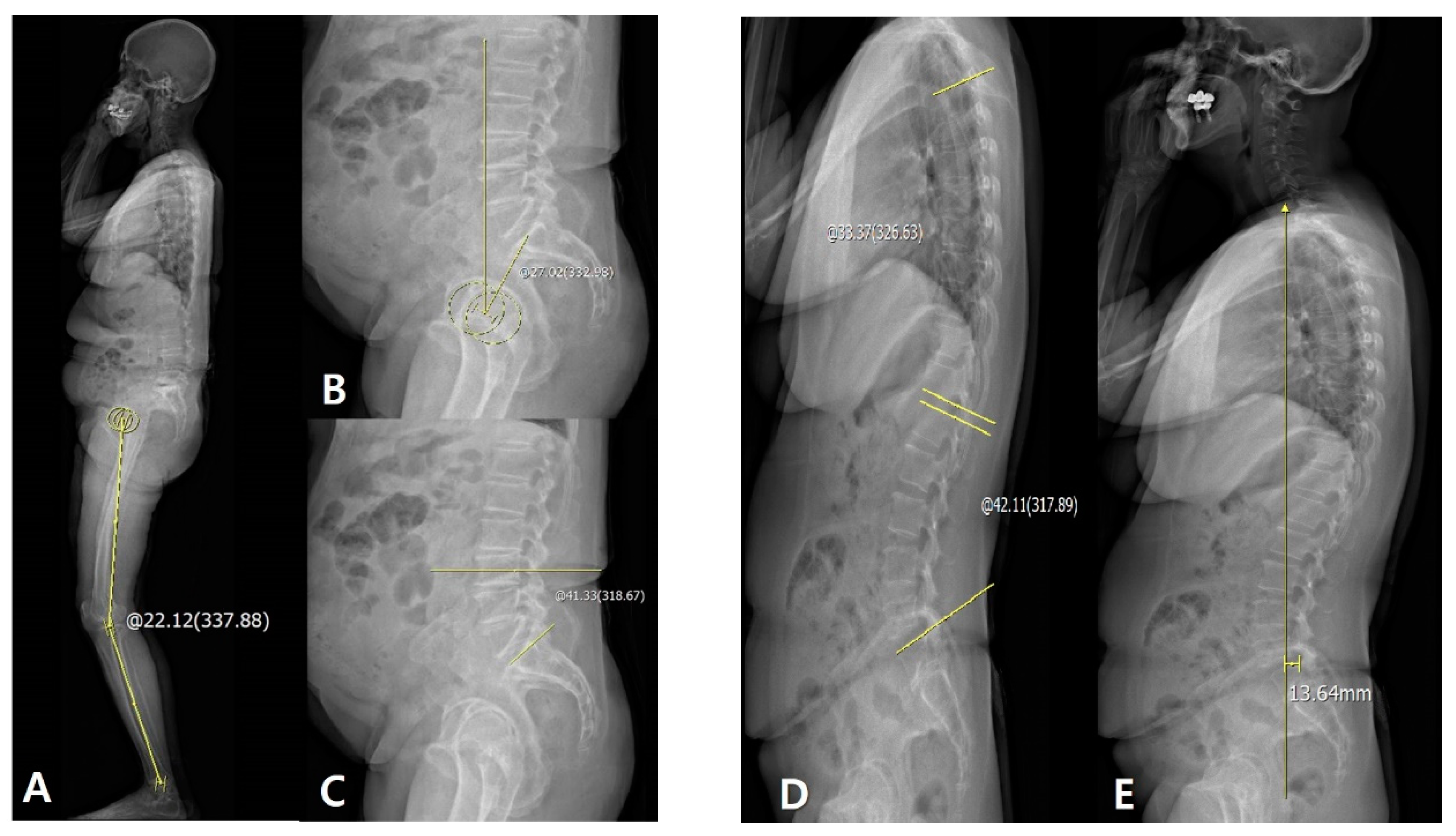
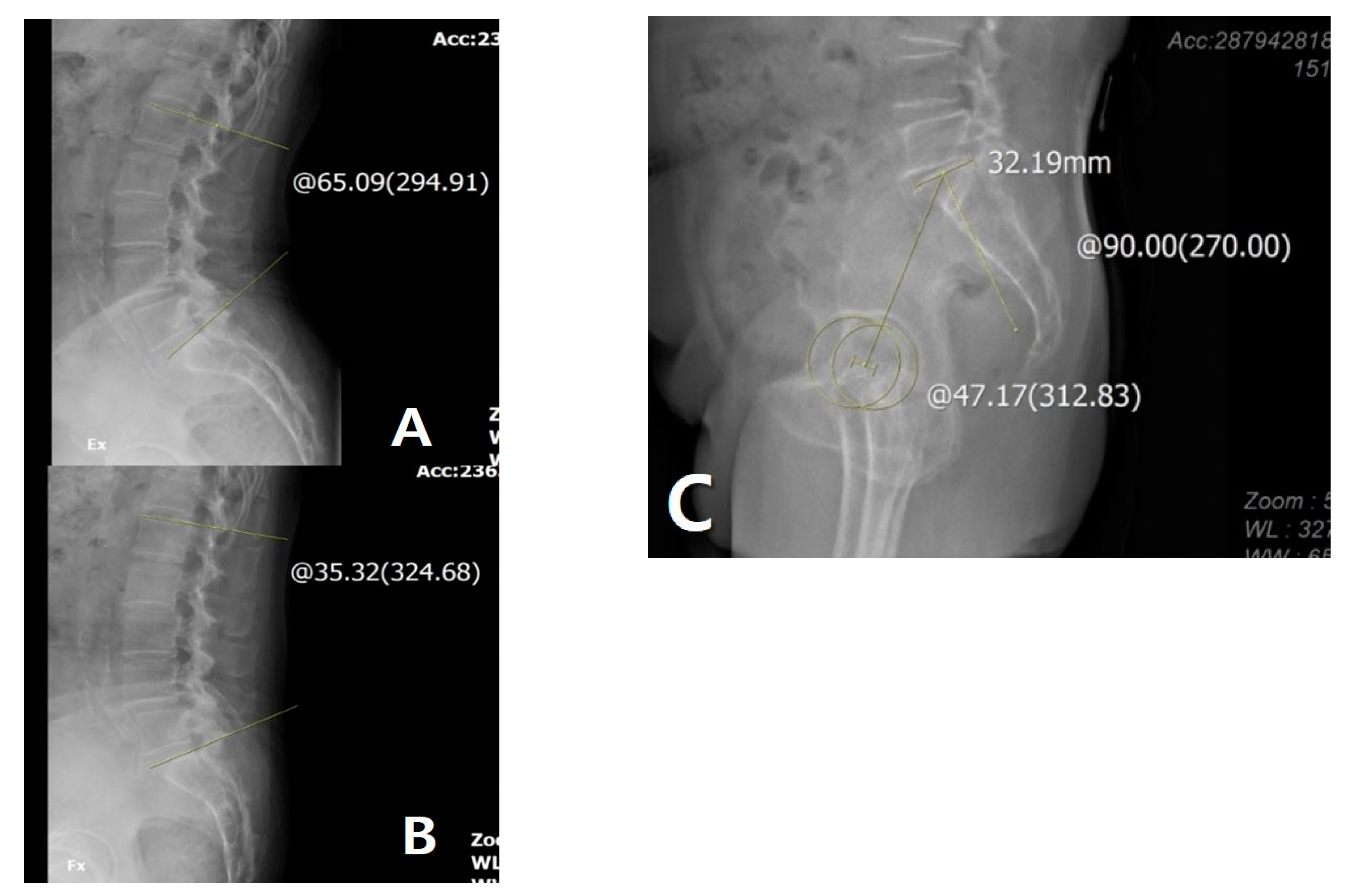
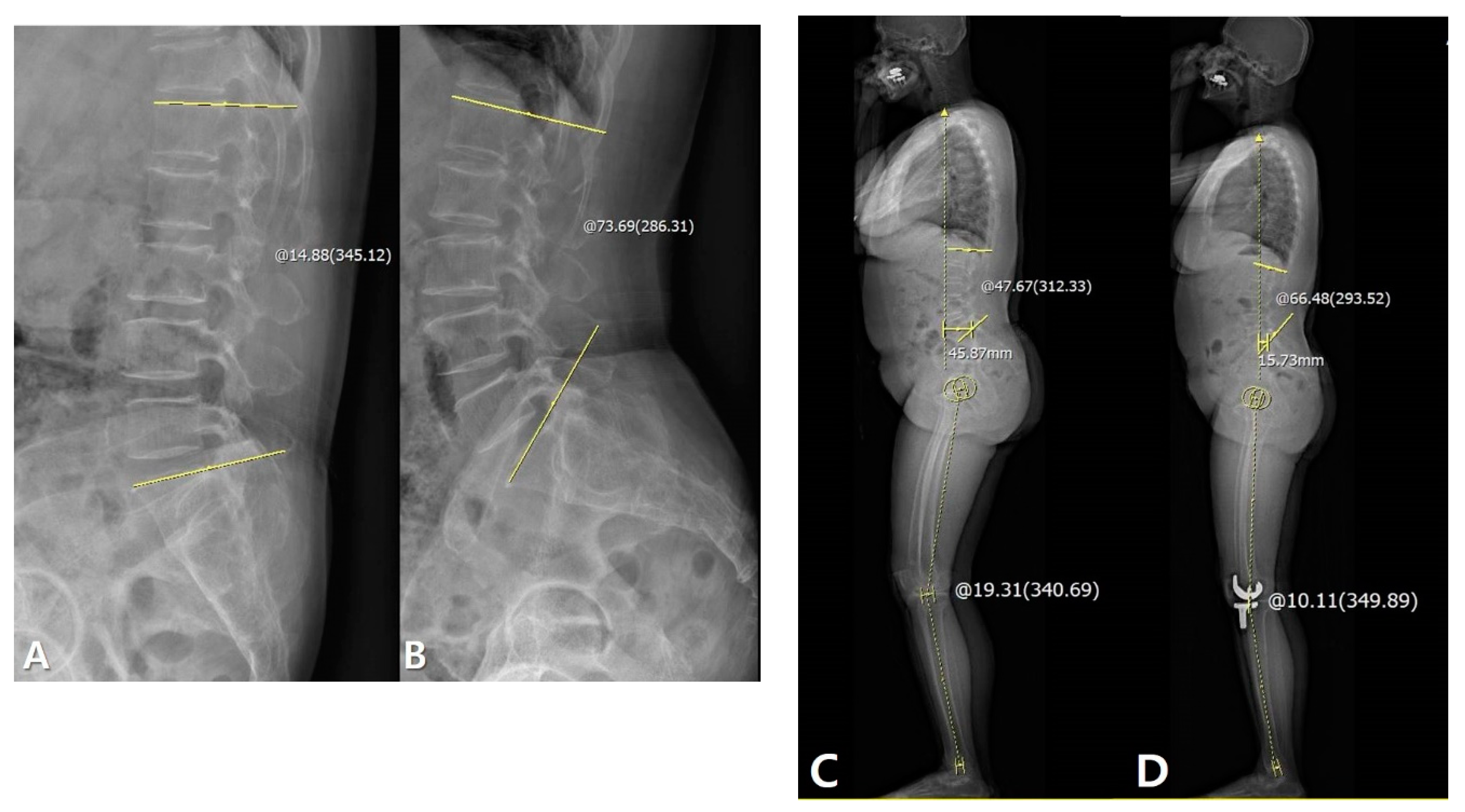
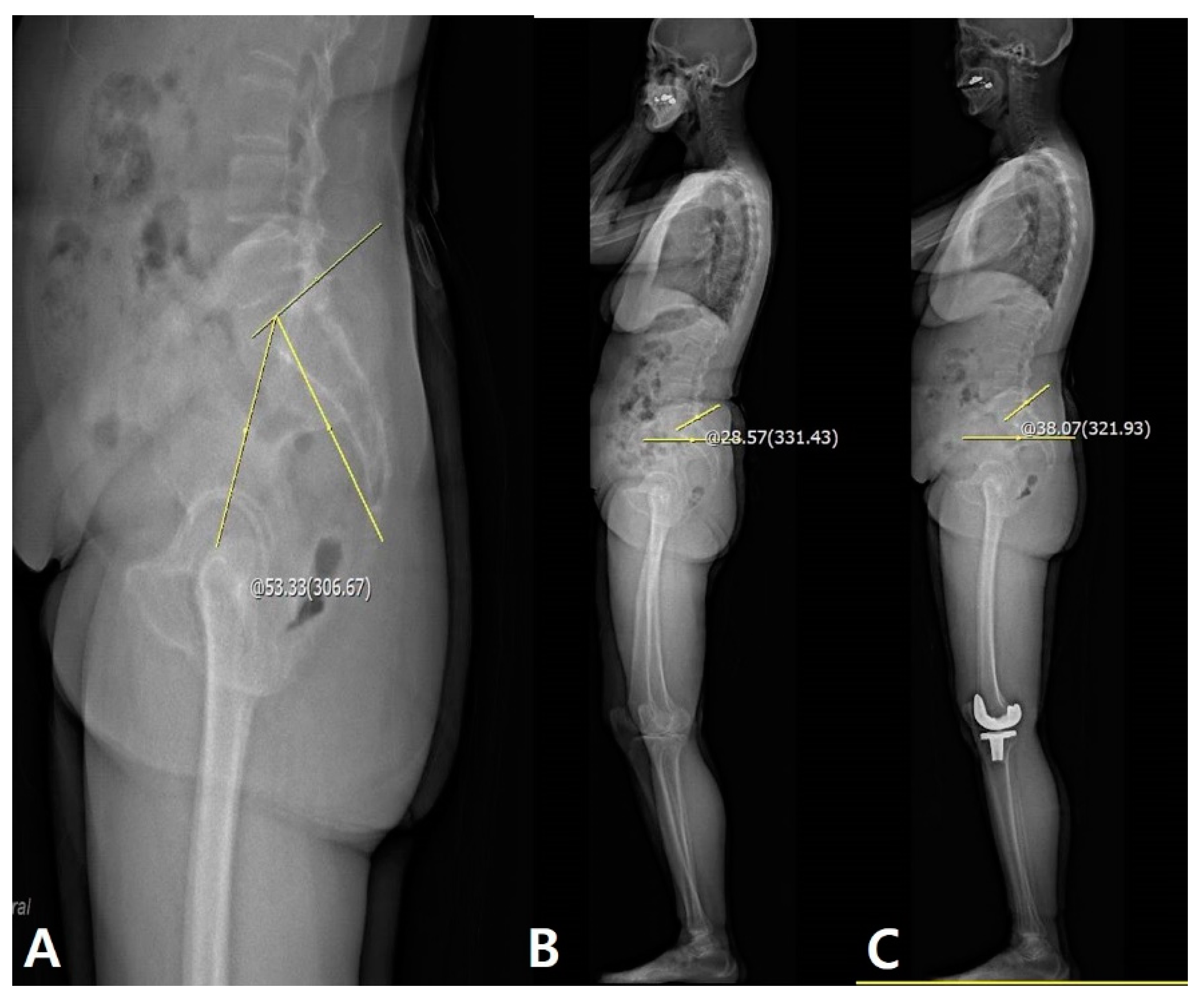

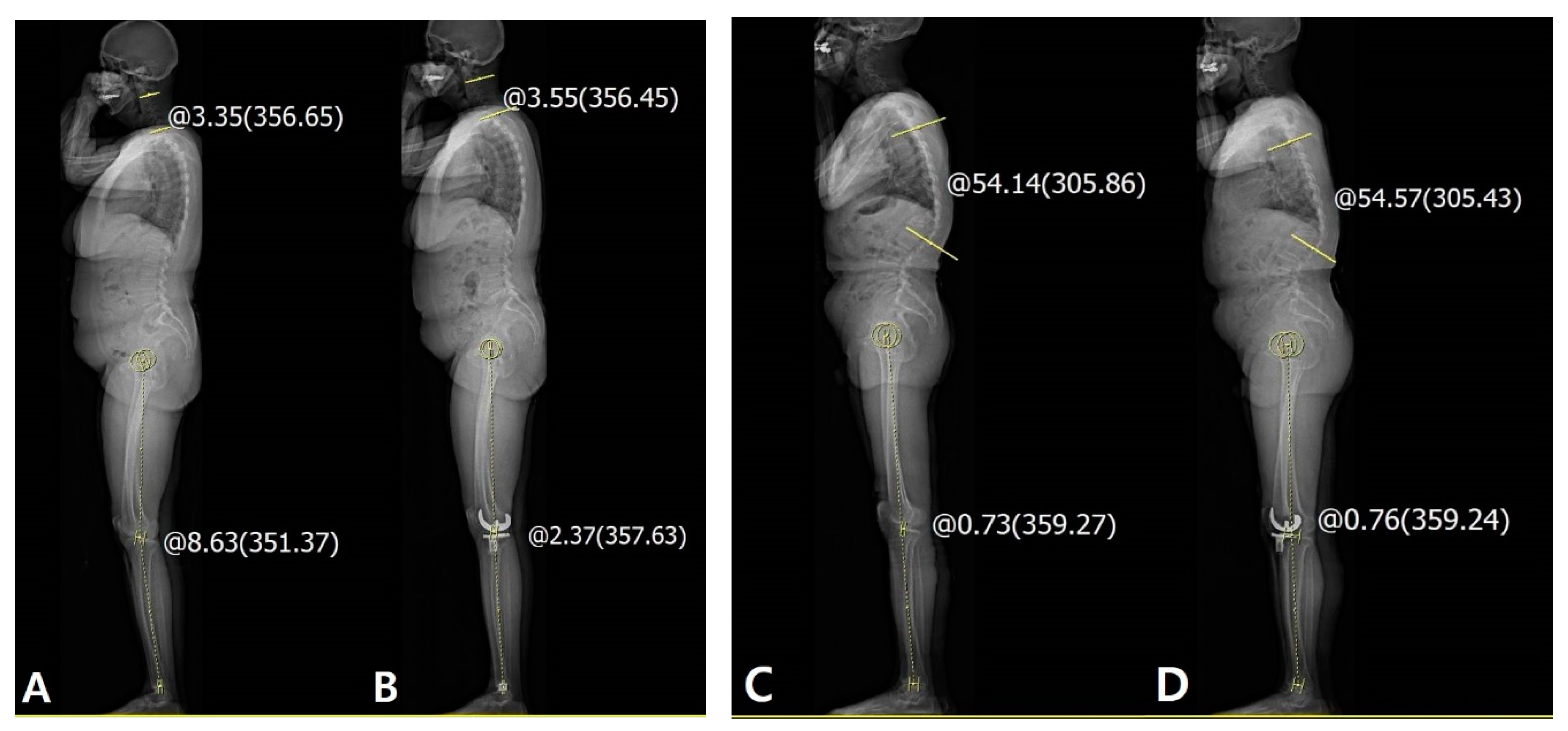
| Parameter | Preoperative | Postop 3 Months | Postop 1 Year | p-Value |
|---|---|---|---|---|
| Clinical parameters (n = 101) | ||||
| Flexion contracture (°) Rt | 9.85 ± 6.26 | 0.24 ± 1.09 | <0.001 | |
| Flexion contracture (°) Lt | 10.19 ± 5.65 | 0.29 ± 1.19 | <0.001 | |
| Radiologic parameters (n = 101) | ||||
| Sagittal HKA angle (°) | 10.57 ± 5.81 | 7.22 ± 5.71 | 5.52 ± 6.22 | <0.001 |
| Thoracic kyphosis (°) | 33.82 ± 10.43 | 33.07 ± 10.66 | 31.29 ± 11.03 | <0.001 |
| Lumbar lordosis (°) | 46.42 ± 12.47 | 48.21 ± 11.47 | 48.62 ± 12.45 | 0.004 |
| SVA (mm) | 25.80 ± 33.54 | 23.45 ± 36.99 | 23.01 ± 33.79 | 0.018 |
| Pelvic tilting (°) | 21.36 ± 8.73 | 18.87 ± 8.05 | 18.68 ± 8.07 | <0.001 |
| Sacral slope (°) | 34.70 ± 7.96 | 37.61 ± 8.39 | 35.73 ± 8.00 | 0.071 |
| Parameter | Preoperative— Postop 3 Months | Preoperative— Postop 1 Year |
|---|---|---|
| ΔThoracic kyphosis (°) | ||
| PCC | 0.161 | 0.092 |
| Significant probability | 0.108 | 0.361 |
| ΔLumbar lordosis (°) | ||
| PCC | −0.165 | −0.206 |
| Significant probability | 0.099 | 0.039 |
| ΔC7 plumb line-sacrum distance (mm) | ||
| PCC | 0.055 | 0.205 |
| Significant probability | 0.582 | 0.040 |
| ΔPelvic tilting (°) | ||
| PCC | 0.148 | 0.013 |
| Significant probability | 0.138 | 0.897 |
| ΔSacral slope (°) | ||
| PCC | −0.034 | −0.032 |
| Significant probability | 0.732 | 0.749 |
| ΔHKA angle (°) | ||
| PCC | 0.023 | 0.113 |
| Significant probability | 0.820 | 0.261 |
| Independent Variable | Dependent Variable | Preoperative— Postop 1 Year | |
|---|---|---|---|
| Regression Coefficient (β) | p-Value | ||
| LF | ΔLL | −0.155 | 0.039 * |
| LF | ΔSVA | 0.681 | 0.040 * |
| PF | ΔSS | −0.208 | <0.001* |
| Parameter | Preoperative— Postop 3 Months | Preoperative— Postop 1 Year |
|---|---|---|
| ΔThoracic kyphosis (°) | ||
| PCC | −0.127 | 0.049 |
| Significant probability | 0.206 | 0.623 |
| ΔLumbar lordosis (°) | ||
| PCC | 0.182 | −0.071 |
| Significant probability | 0.069 | 0.478 |
| ΔC7 plumb line-sacrum distance (mm) | ||
| PCC | −0.024 | −0.050 |
| Significant probability | 0.809 | 0.619 |
| ΔPelvic tilting (°) | ||
| PCC | 0.024 | 0.057 |
| Significant probability | 0.813 | 0.575 |
| ΔSacral slope (°) | ||
| PCC | −0.102 | −0.362 |
| Significant probability | 0.309 | <0.001 |
| ΔHKA angle (°) | ||
| PCC | 0.068 | 0.134 |
| Significant probability | 0.501 | 0.180 |
| Lumbosacral Flexibility | Correlation |
|---|---|
| Lumbar flexibility (°) | |
| PCC | −0.275 |
| Significant probability | 0.005 |
| Pelvic flexibility (°) | |
| PCC | 0.075 |
| Significant probability | 0.456 |
Publisher’s Note: MDPI stays neutral with regard to jurisdictional claims in published maps and institutional affiliations. |
© 2020 by the authors. Licensee MDPI, Basel, Switzerland. This article is an open access article distributed under the terms and conditions of the Creative Commons Attribution (CC BY) license (http://creativecommons.org/licenses/by/4.0/).
Share and Cite
Kim, S.C.; Kim, J.S.; Choi, H.G.; Kim, T.W.; Lee, Y.S. Spinal Flexibility Is an Important Factor for Improvement in Spinal and Knee Alignment after Total Knee Arthroplasty: Evaluation Using a Whole Body EOS System. J. Clin. Med. 2020, 9, 3498. https://doi.org/10.3390/jcm9113498
Kim SC, Kim JS, Choi HG, Kim TW, Lee YS. Spinal Flexibility Is an Important Factor for Improvement in Spinal and Knee Alignment after Total Knee Arthroplasty: Evaluation Using a Whole Body EOS System. Journal of Clinical Medicine. 2020; 9(11):3498. https://doi.org/10.3390/jcm9113498
Chicago/Turabian StyleKim, Seong Chan, Joo Sung Kim, Han Gyeol Choi, Tae Woo Kim, and Yong Seuk Lee. 2020. "Spinal Flexibility Is an Important Factor for Improvement in Spinal and Knee Alignment after Total Knee Arthroplasty: Evaluation Using a Whole Body EOS System" Journal of Clinical Medicine 9, no. 11: 3498. https://doi.org/10.3390/jcm9113498
APA StyleKim, S. C., Kim, J. S., Choi, H. G., Kim, T. W., & Lee, Y. S. (2020). Spinal Flexibility Is an Important Factor for Improvement in Spinal and Knee Alignment after Total Knee Arthroplasty: Evaluation Using a Whole Body EOS System. Journal of Clinical Medicine, 9(11), 3498. https://doi.org/10.3390/jcm9113498






